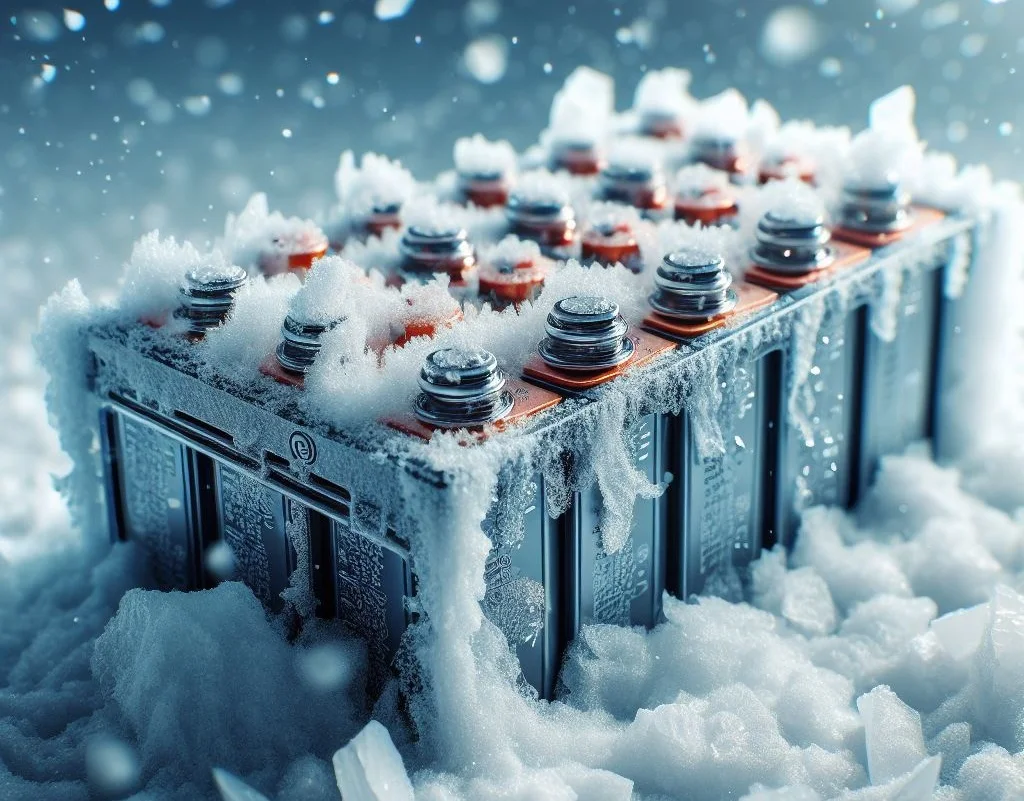A mechanical engineering professor at Drexel University led a group for battery research. According to the research, lithium ion batteries are not suitable in cold environments. The production market for lithium-ion batteries has grown a lot and as a result their prices have decreased. But this type of growth isn’t always good because lithium-ion batteries cannot charge well in cold weather and there is also a big risk of batteries catching on fire.
Image: DIW-AIgen
These batteries have an electromagnetic storage system that stores the energy in the form of ions. When you charge your car or phone with these batteries, the ions present in the battery get activated because of electricity and travel from positive electrode to negative electrode. Electrons also get activated and pass from positive electrode towards negative electrode, alongside ions. When the electric car is switched on, these ions travel back and forth from positive electrode to negative electrode and enable the flow of electricity.
The AA and AAA batteries also work for cars and mobiles but they can only be used once. If you want to use a battery for a long time and charge it as many times as you want, lithium-ion battery is the popular choice. Lithium is one of the lightest metals and it has a specific capacity of storing a huge amount of charge per weight. This is why lithium ion batteries are not only best for portable electronic devices, but for electric cars too.
Even though these batteries are better than AA or AAA, they are more likely to catch fire. In New York City, the electric bike battery fires have increased from 30 to over 250 fires in five years. There can be different reasons why batteries are catching on fire, like poor manufacturing, traces of impurity or traces left behind in batteries and also the climate. The cold areas can bring a lot of change in the performance of batteries. Lithium-ion and other types of batteries have a fluid called electrolytes. When the temperature is low, these electrolytes flow slowly and the lithium ions move towards the electrodes slowly as a result. This prevents the ions from completely inserting into the electrodes and as a result, they only stick to its surface and lithium metal is formed.
The research is thinking of making lithium ion batteries of some other electrolytes that do not become thick in cold temperatures. Sodium-ion batteries can work well in the place of lithium ion and they also cost less and sodium is also available easily.
Read next: The Challenge of Spotting AI-Generated Faces
Image: DIW-AIgen
These batteries have an electromagnetic storage system that stores the energy in the form of ions. When you charge your car or phone with these batteries, the ions present in the battery get activated because of electricity and travel from positive electrode to negative electrode. Electrons also get activated and pass from positive electrode towards negative electrode, alongside ions. When the electric car is switched on, these ions travel back and forth from positive electrode to negative electrode and enable the flow of electricity.
The AA and AAA batteries also work for cars and mobiles but they can only be used once. If you want to use a battery for a long time and charge it as many times as you want, lithium-ion battery is the popular choice. Lithium is one of the lightest metals and it has a specific capacity of storing a huge amount of charge per weight. This is why lithium ion batteries are not only best for portable electronic devices, but for electric cars too.
Even though these batteries are better than AA or AAA, they are more likely to catch fire. In New York City, the electric bike battery fires have increased from 30 to over 250 fires in five years. There can be different reasons why batteries are catching on fire, like poor manufacturing, traces of impurity or traces left behind in batteries and also the climate. The cold areas can bring a lot of change in the performance of batteries. Lithium-ion and other types of batteries have a fluid called electrolytes. When the temperature is low, these electrolytes flow slowly and the lithium ions move towards the electrodes slowly as a result. This prevents the ions from completely inserting into the electrodes and as a result, they only stick to its surface and lithium metal is formed.
The research is thinking of making lithium ion batteries of some other electrolytes that do not become thick in cold temperatures. Sodium-ion batteries can work well in the place of lithium ion and they also cost less and sodium is also available easily.
Read next: The Challenge of Spotting AI-Generated Faces

